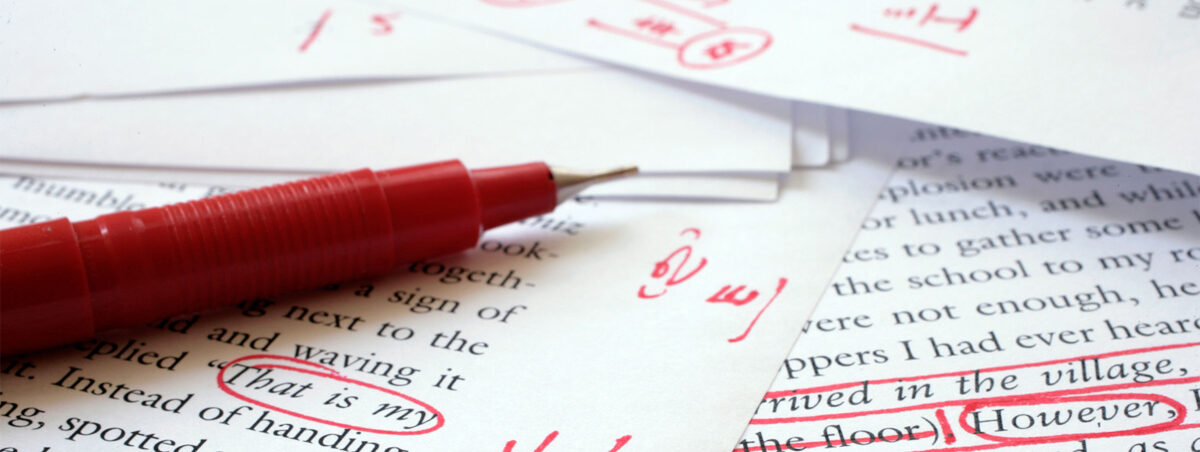* Decades ago, wearying of work in bars and restaurants and at a loss as to what to do with my life but realizing I needed to do I recall having a conversation with an author friend and wondering, vaguely, whether there might be something I could do in publishing, about which I knew, well, nothing. He, very nicely, suggested that I check in with the production editor who supervised his books. Assuming, given my friendship with her exceptionally punctilious author, that I must be at least half intelligent—a daring assumption but, for me, a lucky one—she took a flyer and agreed to give me a proofreading job.
Not a test. A job. (Yes, the past is a foreign country; they do things differently there.

) I’ll always recall our conversation. “Do you have a copy of Merriam-Webster’s ?” “Yes,” I said. “Do you know the proofreading symbols?” “Absolutely,” I lied.
“Do you have a copy of ?” “I’ll get one,” I promised. What a revelation that chunky orange volume was! What a treasure map leading to all sorts of things I, with my at best spotty suburban education in the English language, vaguely knew, vaguely knew but couldn’t name, didn’t know at all. Heavy on the last.
How marvelously definitive, how bracingly steadying, how comfortingly helpful. I used to sit and read it as if it were the latest scorchingly thrilling bestseller. Learning to proofread and, eventually, copyedit by the seat of my pants, literal on-the-job training (augmented by that production editor’s generous mentorship; I’ve never forgotten that and have done my best to, as they say, pay it forward), I was always grateful to have my copy of nearby: a place I could always go to learn precisely what I needed to know.
It was, and has been ever since, like having a very smart and constantly accessible friend. * isn’t merely a guide; it’s a testament to the art of textual precision. Its presence on the desk of the devoted writer is not a matter of mere chance but a reflection of its embodiment of principles that make it indispensable to those who approach writing with the seriousness it demands.
What sets apart is its remarkable versatility. Unlike static volumes that adhere to a single approach for citations, the provides two distinct systems. The Notes and Bibliography format caters to the humanities, a domain in which the disarray of intellectual pursuit is both embraced and scrutinized, while the Author-Date system serves the sciences and social sciences, in which exactitude and clarity reign supreme over the “poetic.
” doesn’t skim the surface of grammatical and syntactical conventions but delves deeply into the labyrinthine complexities. The functions as both a meticulous blueprint and a flexible instrument, adeptly guiding the academic, the professional, and the “literary artist.” The ’s commitment to clarity is underscored by its rich array of examples.
Each “rule” is rendered comprehensible through practical illustrations that illuminate not only the “how” but the “why.” This dedication to elucidation transmutes what might otherwise be pedantic “regulations” into arias of consistency, precision, complexity, and nuance. With a heritage extending back to 1906, is not a relic but a living document, harmonizing historical depth with contemporary relevance.
It evolves in response to modern practices and technological advancements while maintaining the principles that have sustained its significance for more than a century. In academic and professional realms, the ’s authoritative voice is the standard for editing and citation. It embodies the pinnacle of literary excellence, and its regular revisions ensure that it remains aligned with the ever-changing currents of language and practice.
Beyond its exhaustive regulations, the provides practical guidance on matters ranging from manuscript preparation to copyright and ethical issues. It acts as a guiding light through the opaque waters of publishing. In essence, is the quintessential reference for anyone committed to the serious craft and art of writing and editing.
* I first encountered when it was called —that is, when it was in its twelfth edition. Those were the days when galleys were three feet long and when the copyediting department had open on a wooden stand in the center of the room—a room where sunlight streamed in through the leaves of what seemed like dozens of potted plants on the windowsill. It was like a beautiful library where you could stroll in and browse reference books to your heart’s content.
And in those days, everyone used —it wasn’t just for copyeditors. Back then, I was writing a lot of poetry. Everything looked like a poem to me, especially if it was hyperorganized—divided and categorized and separated and ordered.
To me, organization and categorization constitute the soul of poetry, and when I looked up something in the manual, I saw poems in their purest form. Open to a page at random, and find a poem there. Consider the excerpt from a list of subsections in section 5 below.
Fused participles! Who can imagine such a thing? And all that dangling! Chicago should issue a challenge to poets: write a sestina using the words “infinitive,” “participle,” “gerund,” “dangling,” “fused,” and “split.” Another subsection, titled “Voice, Mood, Tense, Person, and Number”—a poem title all by itself—offers more possibilities. There is a love story there worthy of Dante and Beatrice, a romance complete with falsehood, connection, attraction, indication, and.
.. conjugation.
I don’t have the space to delve into the poetry found in the thousands of sentences used as examples—for example, from 5.116, “Complaining about it won’t help,” “I don’t like your cooking,” “His favorite pastime is sleeping,” and “Reduce erosion by terracing the fields”—inspiration just ripe for the picking. John Ashbery would have had a field day.
When I was in high school, I read an anthology called straight through from beginning to end. reminds me of that book—it’s nothing less than a poetry anthology, one you can read in sequence or dip into at your pleasure. Yes, of course I use it as a reference book.
But isn’t its purpose to help editors free the voice that is great within every author? * I’m an AP guy. I learned stylebooks while editing newspapers, so the Associated Press style standards made sense. Newspapers use AP style because it’s crafted for the way that people read newspapers: quickly, over breakfast, on the bus, on the go.
Give them as few reasons to pause reading—as few characters to get tripped up on—as possible. Serial commas? Seriously frowned upon. If readers hit more commas than they need to, they’re more likely to pause reading, get distracted by a gust of wind or a baby squirrel, and then forget to ever start again.
Eventually they read less, grow illiterate, drop out of school, become degenerate, and show up at your house to rob and kill you. All because you wanted a second comma in “red, white, and blue.” How un-American.
Numbers? AP uses numerals for everything larger than nine. If you’re trying to count ninety-nine bottles of beer on the wall—rather than 99—you’ll get drunk on all the extra characters, and by the time you hit the seventies, you’re barely able to count, much less punctuate. En dashes? They’re dead to any AP stylist.
Just how many horizontal lines do you need? AP style is crisp, quick, efficient—ruthlessly engineered for a world that thrives on efficiency. That’s why feels so..
.lazy. Adding in serial commas? Spelling out numbers all the way through one hundred? Distinguishing among em dashes, en dashes, and hyphens? Each one slows you down.
Asking readers to actually take their time? It’s like Chicago wants readers to luxuriate. In. The.
Pauses. The AP editor has reams of copy to get through before the presses start. Put a skinny little hyphen between those date ranges and page ranges and call it a night.
The Chicago editor has all the time in the world to convert those hyphens to en dashes. Unencumbered by daily deadlines, that editor can breathe as easy as the numbers on either side do with the extra room that the en dash grants them. It’s not just about the editors.
With Chicago style, readers also feel that airiness and relief. They relax. They absorb.
They process. They enjoy. Who’s got time for all that? * For a newspaper copyeditor at the end of the last century, style guides were short alphabetical lists of local quirks and recent editions of .
Before I left newspapers and expanded my view as a freelance editor, I only knew the en dash as a typographical anomaly—not something copyeditors needed to concern themselves with. was not an important part of my professional life. Now, I routinely consult a number of style guides in my daily work, including, of course, .
Even for clients who consider themselves strictly AP or APA (the ), I look to for guidance. And why not? Style guides give us the comfort of familiarity and guidelines for understanding. Each of the style guides on my bookshelf and on my computer is written by thoughtful people who care about language and have endeavored to guide us on how best to style our communications.
The preface to the new 18th edition leads with a quote from the preface to the first edition from 1906: Rules and regulations such as these, in the nature of the case, cannot be endowed with the fixity of rock-ribbed law. They are meant for the average case, and must be applied with a certain degree of elasticity. Quite a bit of the original preface is devoted to the idea that your mileage may vary—don’t take this or any style manual as gospel, but know that local habits, exigencies of typesetting, and pride of authorship might be good excuses for setting your own course.
The preface concludes by explaining that the book’s main purpose is internal, to guide the university press. However: If, in addition to this its main object, this may incidentally prove helpful to other gropers in the labyrinths of typographical style, its purpose will have been abundantly realized. The success of subsequent editions and the excitement 118 years later over the new 18th edition proves that its purpose has been abundantly realized.
We gropers in the labyrinths of typographical style should be forever grateful to those who set down some principles to guide us while giving us the freedom to judge each case on its merits, to know that adherence to rock-ribbed law may sometimes prove ill-suited to the goal of communicating clearly. Certainly we find in the 18th edition that changes are necessary for new attitudes about capitalization and race and a greater acceptance in the 21st century of the singular . Those changes—just a portion of a great many revisions—are following a trend, describing the language as it is and not prescribing what it should be.
Now that I have a great many general and specialized style guides and usage manuals at my fingertips, I still rely on to help me in my daily efforts to add clarity to the written word. That Word Chat I don’t mean to brag, but I am probably the only person on the planet who has taken to all fifty U.S.
states. I have hauled it onto airplanes, down the streets of multiple major metropolitan areas, onto beaches, and even up the side of a mountain in Alaska. I have a traveling pop-up grammar advice stand, called the Grammar Table, which I sit at in public places in order to answer the grammar questions of passersby.
I like to have reference materials on the table in order to model the looking-things-up lifestyle I lead, and is part of that lifestyle. Details delight me. One of my favorite destinations is the hyphenation table in section 7.
96. While extremely organized and tidy, it never pretends that hyphens and compounds are simple. It is fourteen chaos-conquering pages long.
If you are a writer-director, you get hyphenated. If you one day have great-great-grandchildren, hyphenate them. But if you are catlike or softheaded, no hyphens.
Because of all the -hauling I’ve done, my arms and back are just a little bit stronger than they might otherwise have been. Yes, fed my brain, but the weight of the brain food may also have added a couple of days, or maybe at least a couple of hours, to my life. With my extra time, I salute this book! * Sweet heaven—there are people who care about this kind of thing? On first looking into , I was convinced I’d found .
A childhood in the US followed by high school in England made me perhaps unusually attentive to variation within the English language. I was struck not only by the obvious differences in spelling ( , ) and diction ( , ), but dozens of other details that I’d never noticed before, things no one had told me to expect: inverted commas instead of double quotation marks, commas sometimes inside and sometimes outside quotations, periods (full stops!) seemingly missing in abbreviations like and , and so on. Without a guide I was left to try to intuit the patterns and their scope.
I first got my hands on the when I returned to the US as a first-year undergrad. This was the 1980s, shortly after the appearance of the 13th edition, so I got someone’s discarded 12th edition for a song. I bought it entirely out of curiosity.
It not only helped me make sense of all the oddities I’d noticed when I lived abroad; it also gave me a universe of new things to think about. Is it or , or , or ? I’d never thought about these things—didn’t even realize they were things to think about. I found it all strangely exciting, in an endearingly nerdy way, and the more minute and obscure the guidelines the more I enjoyed them.
I started thinking about the differences between apostrophes and prime marks, the usage of hyphens and en dashes and minus signs, and the capitalization of geological eras. Over time the logic for the guidelines became clear. There are good reasons to impose uniformity on natural linguistic variety, even when the uniformity is entirely arbitrary.
The helped me to understand what had been a mystery before: that usages aren’t always or (which I very much wanted to believe when I was young), but can be and . What’s more, digging into the minutiae taught me bigger lessons about the language. It took me time and effort to make sense of the rules for hyphenating compounds, and that work effort ultimately helped me understand much grander things about how our language is put together.
What at first seemed merely deliciously eccentric and obsessive became genuinely informative (but still also deliciously eccentric and obsessive). The 12th edition was nearly two decades old when I got it. I soon upgraded to the state-of-the-art 13th and found a new universe of things to care about.
Since then I’ve had a series of side hustles to supplement my academic career—proofreader, copyeditor, volume editor—and I’ve made a habit of getting and inhaling each edition as soon as it appears. I’m eagerly awaiting the 18th. You Could Look It Up: The Reference Shelf from Ancient Babylon to Wikipedia __________________________________.



















